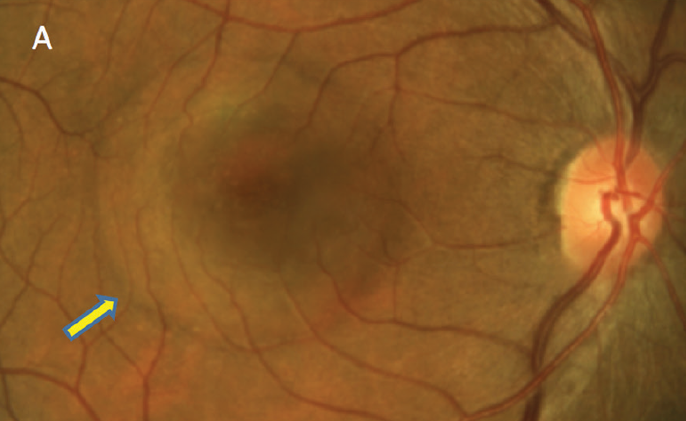 |
| The strong association between male sex and CSC was again demonstrated in this study, but researchers also identified a number of others to be mindful of for a fuller picture of the condition. Photo: Mohammad Rafieetary, OD. Click image to enlarge. |
New findings, recently published in Journal of Ophthalmology, identified several risk factors associated with central serous chorioretinopathy (CSC), including male sex, shift work, Helicobacter pylori infection, hypothyroidism and elevated levels of vascular endothelial growth factor (VEGF), high-sensitivity C-reactive protein (hs-CRP) and erythrocyte sedimentation rate (ESR).
The analysis, conducted at Shijiazhuang People’s Hospital in China, included 109 patients diagnosed with CSC from 2017 to 2021. The control group was comprised of 103 volunteers from the hospital’s health examination center.
Additionally, the researchers used multimodal imaging to classify the central serous patients into simple (57 cases) and complex (52 cases) CSC. They collected demographic information, underlying conditions, medical history and medication history. Levels of VEGF, high-sensitivity C-reactive protein and ESR were also measured.
Data showed a higher proportion of male subjects, smoking history, alcohol consumption, comorbid obstructive sleep apnea, hypothyroidism, renal disease, Helicobacter pylori infection, steroid use and shift work among the CSC cohort compared with the control group. Levels of VEGF, hs-CRP and ESR were also significantly higher in patients with central serous chorioretinopathy.
Researchers reported higher levels of VEGF, high-sensitivity C-reactive protein and erythrocyte sedimentation rate among patients in the complex CSC group when compared to their simple CSC counterparts. “VEGF plays a pivotal role in angiogenesis and vascular permeability, promoting endothelial cell proliferation and neovascularization,” the researchers noted in their paper on the work.
The team also reported that the combined diagnostic value of VEGF, high-sensitivity C-reactive protein and erythrocyte sedimentation rate was higher compared with that of individual markers, with an area under the curve (AUC) value of 0.886 for all three together; separately, the AUC values ranged from 0.703 to 0.728. AUC analysis quantifies the strength of the association between variables, with 1.00 being perfect correspondence and 0.50 being a purely random result.
“CSC has emerged as the fourth most common retinal disorder following age-related macular degeneration, diabetic retinopathy and retinal vein occlusion. Unlike other retinal diseases, central serous chorioretinopathy often resolves spontaneously without intervention, but some patients may experience visual impairment,” the study authors wrote in their paper, while also noting that despite the efficacy of current treatment modalities, the recurrence rate is still high. “Understanding the risk factors for CSC and analyzing relevant biological markers play crucial roles in clinical prevention strategies.
“Our study identified male gender, shift work, Helicobacter pylori infection and hypothyroidism as predominant risk factors for central serous chorioretinopathy, with elevated levels of VEGF, hs-CRP and ESR associated with CSC development,” they concluded in the paper. “VEGF, high-sensitivity C-reactive protein and erythrocyte sedimentation rate hold promise as biological markers for CSC diagnosis.”
| Click here for journal source. |
Sun L, Yin L, Wang S, et al. Risk Factors and VEGF, hs-CRP, and ESR in Central Serous Chorioretinopathy. J Ophthalmol. September 19, 2024 [Epub ahead of print]. |


